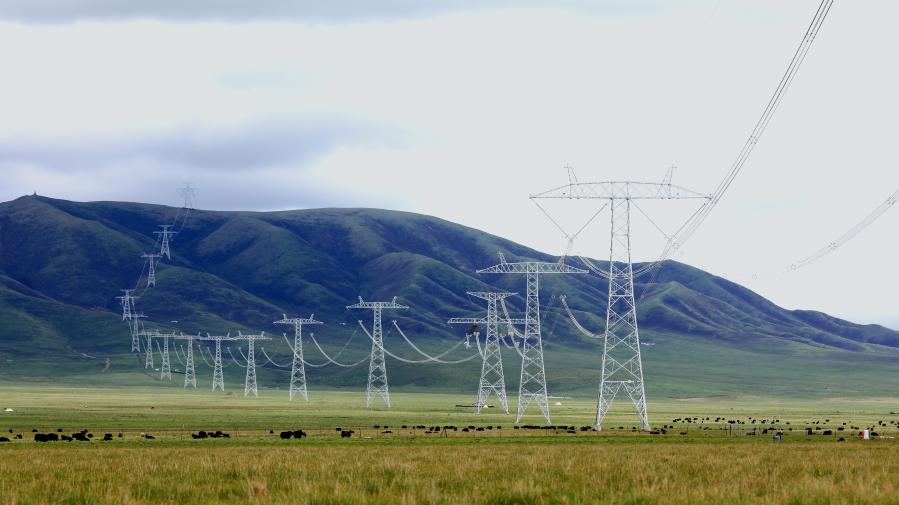China makes steady headway in promoting green energy transition
China has made inspiring progress in advancing its green energy transition, laying a solid foundation for peaking the country’s carbon dioxide emissions by 2030.
Starting in mid-October 2021, China began the construction of large wind power and photovoltaic (PV) projects in the sandy areas, rocky areas and deserts of north China’s Inner Mongolia Autonomous Region and northwest China’s Gansu Province, Ningxia Hui Autonomous Region, and Qinghai Province. While catalyzing green and low-carbon energy transition, these projects will also help boost the development of relevant industries and the local economy.

Photo taken on June 17, 2021, shows part of the Qinghai-Henan UHV DC power transmission line in Henan Mongolian Autonomous County of Huangnan Tibetan Autonomous Prefecture, northwest China's Qinghai Province. (Photo by Xie Lirong/Xinhua)
In recent years, the country’s installed capacity for renewable energy resources, such as wind power and PV power, has continued to expand. As of the end of November 2021, the country’s installed wind power capacity had soared 29 percent year-on-year to about 300 million kilowatts, while its solar power capacity had reached about 290 million kilowatts, up 24.1 percent from a year ago. By comparison, the country’s total installed power generation capacity stood at 2.32 billion kilowatts, up 9 percent year-on-year.
Meanwhile, the country’s utilization level for renewable energy resources has continuously improved. The utilization rates for wind power and PV power generation in 2021 were 96.9 percent and 97.9 percent, respectively, and the water energy utilization rate was 97.8 percent. In 2020, the average levelized cost of onshore wind power and PV power generation in China dropped 10 percent and 18 percent year-on-year, respectively.
In late October last year, China’s State Council released an action plan to peak carbon dioxide emissions before 2030. According to the action plan, the country will maintain its commitment to cutting carbon emissions in a safe manner by vigorously promoting the substitution of renewable sources of energy under the condition that energy security is ensured, all while accelerating the development of a clean, low-carbon, safe and efficient energy system. China aims to increase the share of non-fossil energy as a proportion of its total energy consumption to around 20 percent by 2025, according to the country’s Outline of the 14th Five-Year Plan (2021-2025) for National Economic and Social Development and the Long-Range Objectives Through the Year 2035.
China has been vigorously promoting the clean and efficient utilization of fossil energy. The country has been ranked among leading countries in terms of the efficiency of coal consumption in its coal-fired power generation units. By the end of 2020, it had approximately 950 million kilowatts of installed capacity in ultra-low emission units, and over 800 million kilowatts of installed capacity in units that had undergone energy-saving transformation. The average coal consumption of thermal power plants has decreased to 305.8 grams of standard coal per kilowatt-hour, down more than 27 grams compared with 2010. The energy saved represents a reduction of 370 million tonnes of carbon dioxide emissions by coal-fired power generation units in 2020 compared with 2010.
The country will promote coal substitution as well as its transformation and upgrading, accelerate energy-saving upgrades and flexibility retrofits on coal-fired generating units that remain in service, and actively advance retrofits in coal-fueled heating facilities.
Going forward, China will improve systems for keeping energy consumption under control in terms of both volume and intensity, with especially strict controls on intensity and reasonable controls on volumes during the 14th Five-Year Plan period, according to the country’s National Energy Administration. In the same period, China will also regulate oil and gas consumption.
The country will also build a new electric power system with the share of new energy resources rising further and will continue to develop energy storage systems to convert the unstable electricity generated by power stations using new energy resources such wind and solar energy into stable electrical energy supplies. By 2025, the installed capacity of new types of energy storage will reach 30 million kilowatts or more. By 2030, the installed pumped-storage hydropower capacity will reach approximately 120 million kilowatts, and provincial-level electrical grids will be equipped with peak load response capacity of 5 percent or more.
At the end of last year, the Fengning pumped storage power station in north China’s Hebei Province, the world’s biggest pumped-storage hydroelectric power plant, was put into operation. Consisting of 12 pump-turbine units, the station has a designed annual power generation capacity of about 6.6 billion kilowatt-hours and an annual power pumped-storage capacity of about 8.8 billion kilowatt-hours.
In addition, China will make vigorous efforts to enhance the overall adjustable capacity of its electric power system. It will expedite the construction of flexible power sources into the regulation of the country’s power system, incorporating enterprise-affiliated power plants and the load of traditional energy-intensive industries, as well as interruptible industrial and commercial loads, electric vehicle charging grids, and virtual power plants. The country will build resilient smart electrical grids and make grids more secure and reliable.
China will promote the coordination of power source-grid-load-storage, use multiple energy sources to supplement each other, and support the deployment of appropriate energy storage systems for distributed new energy sources.
Photos
Related Stories
- BiH, China launch construction of green energy project
- China-Africa cooperation supports Africa's transition to green energy
- Top scientists discuss carbon governance at World Laureates Forum
- BRI nations called on to develop green energy
- Int'l desert forum seeks to tap green energy potential
- China's pledge to stop building new coal power plants overseas welcomed: AIIB
Copyright © 2022 People's Daily Online. All Rights Reserved.










